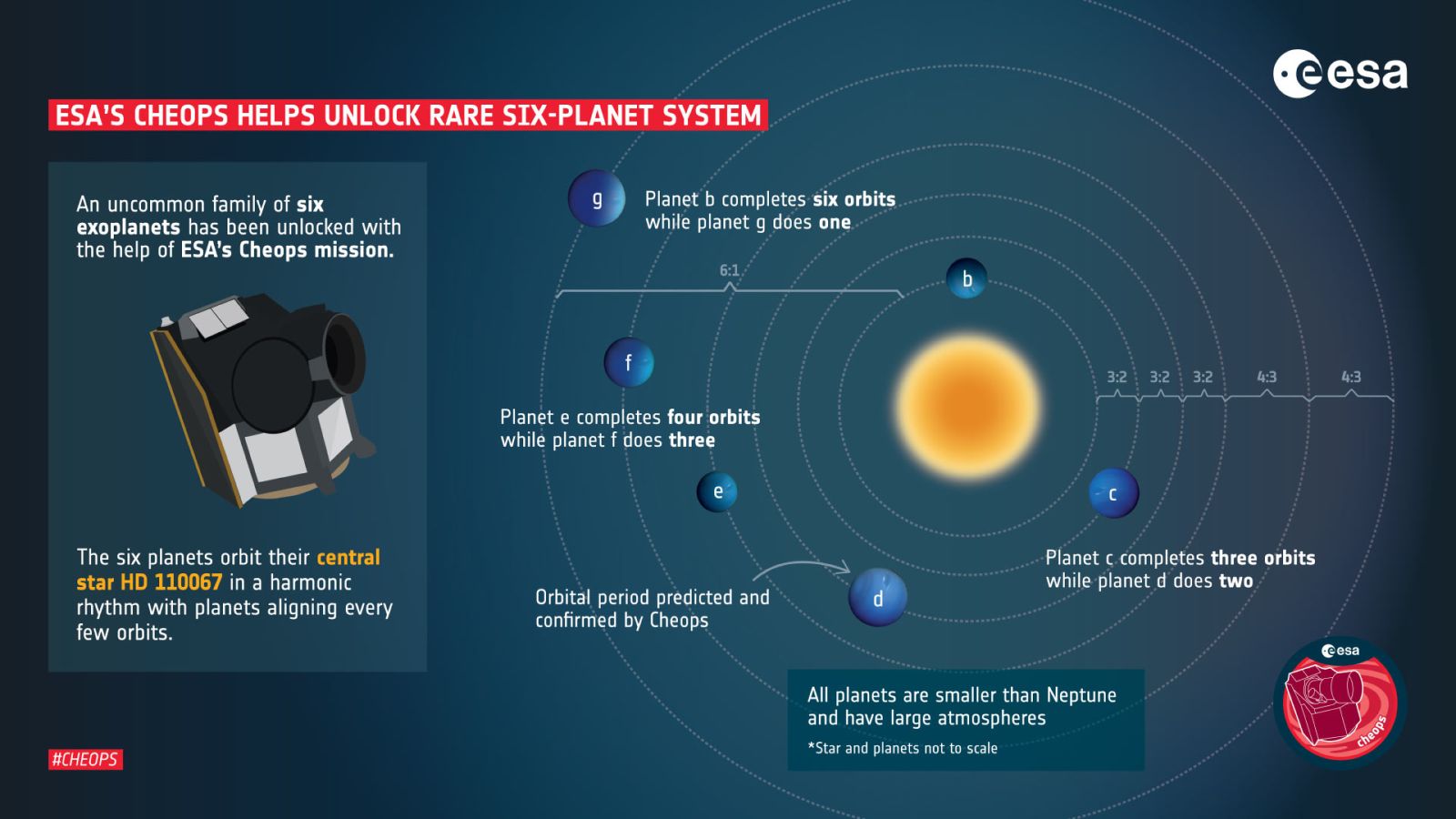The most important task of Cheops, a space telescope of the European Space Agency (ESA) is the in-depth investigation and characterization of known exoplanets outside of our Solar System. However, this may come with unexpected discoveries, as it was in the case of the exoplanetary system around the star HD 110067. This time the Cheops consortium, which has several Hungarian experts within its science team and board members, namely Tamás Bárczy (ADMATIS Kft., Miskolc), Szilárd Csizmadia (Institut für Planetenforschung, DLR, Berlin), László Kiss (HUN-REN CSFK, Budapest), Attila Simon (Universität Bern) and Gyula M. Szabó (ELTE Gothard Astrophysical Observatory, Szombathely), has made some real detective work exploring this system.

The Cheops space telescope (artist's impression)
The HD 110067 system, which is the subject of the research published in Nature, was first observed by TESS in 2020, when dips seen in the light curve of the star indicated exoplanet transits. However, the observed data could not have been explained as a result of two exoplanets orbiting the central star. This is where Cheops entered the picture. As part of its scientific programme, the task of one of the working group within Cheops was to give comprehensive pictures of multiplanetary systems by extracting the most information with the least amount of observations possible. The research group concluded that TESS detected the signal from more than two exoplanets. The main question was, if there really was a third planet orbiting the star, when can one expect its transit? By narrowing down the number of possible orbiting periods of the planet as efficiently as possible - through real detective work - the expected time of the transit was revealed. When Cheops was pointed at the star at the calculated time of the transit, the signal of the third exoplanet around HD 110067 was detected beyond all doubt.
However, the real research work has only just started. It turned out that the orbital periods of the three planets are in resonance with each other - as planet b orbits its star three times, planet c concludes two orbits. A similar relationship was present between planets c and d, thus it was presumed that if there are other planets orbiting the star, they could be "synchronized" similarly with each other, which would facilitate their discoveries. Even after the detection of the three planets, unidentified transits – so-called duo- and monotransits – remained in the light curves of TESS, which could not be linked to any of the known planetary bodies. In the case of a duotransit, the passage of the same exoplanet was detected twice, but the planet's orbital period was still degenerate; the observed transits can result from several orbital configurations. Identifying the correct orbital period is even more difficult in the case of monotransits, when only one transit of an exoplanet has been detected, so there is essentially no information about its orbital configuration. However, in the case of resonances, the orbits of these planets can also be explored using the orbits of planets already discovered in the system. As a result of the resonant configurations and appropriate investigative work, the veil was quickly lifted from the duo- and monotransits. It turned out that there are a total of six exoplanets orbiting in resonance with each other around the star! HD 110067 is thus the brightest star known to host more than three exoplanets. What does this interesting dynamical configuration – the like of which has only been discovered twice until now – reveal about the system?

The six sub-neptunes of the HD 110067 system and their orbits. The orbital period of the innermost planet is slightly more than 9 days, while the outermost planet (planet g) has an orbital period of 54.77 days. Resonances between the different planetary orbits are indicated by pairs of numbers.
The orbits of exoplanets carry information about their formation and their history of evolution. In most planetary systems, planetary orbits are in resonance with each other after their formation, but later this configuration gets disrupted as a result of some external effect (e.g. impacts, the passing of a nearby star, effects of giant planets), therefore it is extremely rare for a system to preserve its initial configuration. The fact that the planets around HD 110067 have remained in resonance even after one billion years of their formation, indicates that the system was not affected by events that would have significantly altered the dynamics of the planets during their evolution. However, these extrasolar planetary bodies investigated in this research are not only interesting targets because of their unique orbital configurations. All six planets are sub-neptunes, meaning that their structures are similar to that of gas planets, and probably have large hydrogen atmospheres. The nature of these planets combined with the high apparent magnitude of the central star, makes them ideal targets for the James Webb Space Telescope (JWST) for atmospheric characterization. Through high precision spectroscopy, JWST will be able to examine the composition of the atmospheres of these distant planets.
The video shows the orbits of the six exoplanets around the central star. Through sonification it provides a better insight into the dynamical harmonies of the resonant configuration in the system.
(cover image: Thibaut Roger/NCCR PlanetS)